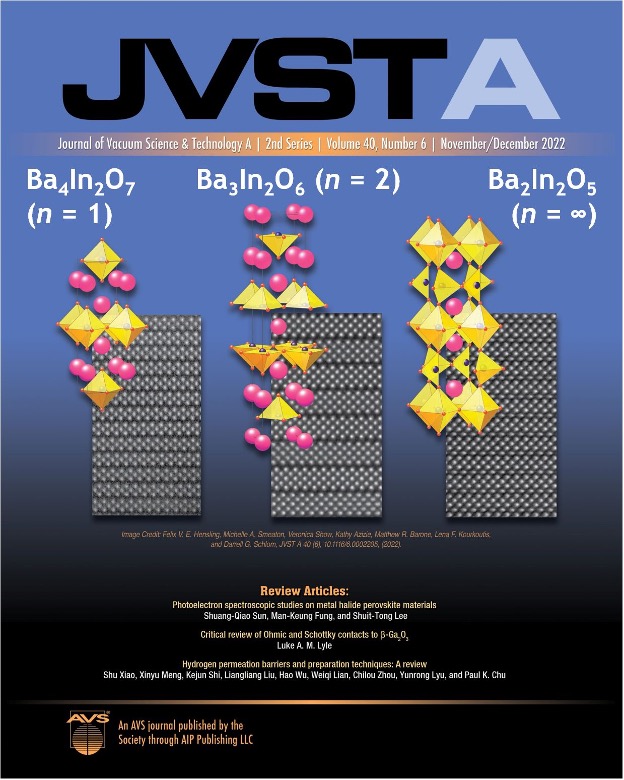PARADIM Highlight #65—In-House Research (2022)
Lena F. Kourkoutis and Darrell G. Schlom (Cornell University)
A recent study in which machine learning was applied to suggest potential high-temperature superconductors predicted that Ba3In2O6 should superconduct at around 46 K [Z.-L. Liu et al. APL Mater. 8, 061104 (2020)]. Though no barium indate superconductors are known, Ba3In2O6 has a crystal structure that resembles YBa2Cu3O7 and other well-known cuprate superconductors

Figure 1: Cover of the November/December 2022 issue of the Journal of Vacuum Science and Technology A that features the newly discovered phases and the electron micrographs of the epitaxially grown samples realized at PARADIM.
Thin films of Ba3In2O6 had never been made and PARADIM researchers were able to grow the desired phase using a new variant of molecular-beam epitaxy (MBE), suboxide MBE, developed in PARADIM. In addition to succeeding in the growth of the targeted phase, Ba3In2O6, PARADIM researchers also discovered a new barium indate phase with an even simpler crystal structure, Ba4In2O7, that is analogous to the first high-temperature cuprate superconductor discovered, (La,Ba)2CuO4.
These phases are shown at the right in both cartoon form and high-resolution electron microscope images of the thin films grown. These phases are n = 1, 2, and ∞ members of a family of structurally related phases known as Ruddlesden–Popper phases with general formula Ba𝑛+1In𝑛O2.5𝑛+1 of which the 𝑛=1 member was previously unknown. The high-temperature superconducting cuprates also belong to this same family of structures. In addition to Ba3In2O6, Ba4In2O7 also warrants study as a potential high-temperature superconductor when doped with electrons or holes. This will be the subject of future work.
We demonstrate the epitaxial growth of the first two members, and the 𝑛=∞ member of the homologous Ruddlesden–Popper series of Ba𝑛+1In𝑛O2.5𝑛+1 of which the 𝑛=1 member was previously unknown. The films were grown by suboxide molecular-beam epitaxy where the indium is provided by a molecular beam of indium-suboxide [In2O (g)]. To facilitate ex situ characterization of the highly hygroscopic barium indate films, a capping layer of amorphous SiO2 was deposited prior to air exposure. The structural quality of the films was assessed by x-ray diffraction, reflective high-energy electron diffraction, and scanning transmission electron microscopy.
This work is the first step in following up on a prediction from machine learning that the barium indate phase Ba3In2O6 is a high-temperature superconductor. Ba3In2O6 is the 𝑛=2 member of the Ruddlesden–Popper series of Ba𝑛+1In𝑛O2.5𝑛+1 and had previously only been synthesized as a powder, which reacted rapidly when exposed to air. Epitaxial thin films are easier to test for superconductivity, easier to dope with holes or electrons, and easier to protect from reacting with air. Further, we discovered that the 𝑛=1 member of the Ruddlesden–Popper series of Ba𝑛+1In𝑛O2.5𝑛+1, specifically Ba4In2O7, could also be synthesized in the form of an epitaxial thin film. Both are isostructural with high-temperature cuprate superconductors, begging the question of whether these barium indates can be suitably doped to become superconductors.
These phases were made by a new variant of molecular-beam epitaxy called suboxide MBE developed by PARADIM and subsequently used in many user projects. The suboxide involved in this achievement is a molecular beam of In2O. Suboxide MBE enables alternative reaction pathways to be followed, often leading to the synthesis of difficult to synthesize oxides. PARADIM’s excellent electron microscopy capabilities were also utilized to confirm the structure of the new phase as well as investigate the microstructure of these films are are unstable in air.
The work was conducted by members of the PARADIM in-house research team.
F.V.E. Hensling, M.A. Smeaton, V. Show, K. Azizie, M.R. Barone, L.F. Kourkoutis, and D.G. Schlom, "Epitaxial growth of the first two members of the Ban+1InnO2.5n+1 Ruddlesden–Popper homologous series," J. Vac. Science & Technol. A 40, 062707 (2022)
F.V.E.H., M.A.S., V.S., K.A., M.B., L.F.K., and D.G.S. acknowledge support from the National Science Foundation [Platform for the Accelerated Realization, Analysis, and Discovery of Interface Materials (PARADIM)] under Cooperative Agreement No. DMR-2039380. Substrate preparation was performed in part at the Cornell NanoScale Facility, a member of the National Nanotechnology Coordinated Infrastructure (NNCI), which is supported by the National Science Foundation (Grant No. NNCI-2025233). This work made use of the Cornell Center for Materials Research Shared Facilities, which are supported through the NSF MRSEC program (DMR-1719875). M.A.S. acknowledges additional support from the NSF GRFP under Award No. DGE-2139899. This research was funded in part by the Gordon and Betty Moore Foundation’s EPiQS Initiative through Grant No. GBMF9073 to Cornell University. F.V.E.H. acknowledges funding by the Alexander von Humboldt foundation in the form of a Feodor Lynen fellowship. The authors acknowledge Sean Palmer for substrate preparation and technical support.







